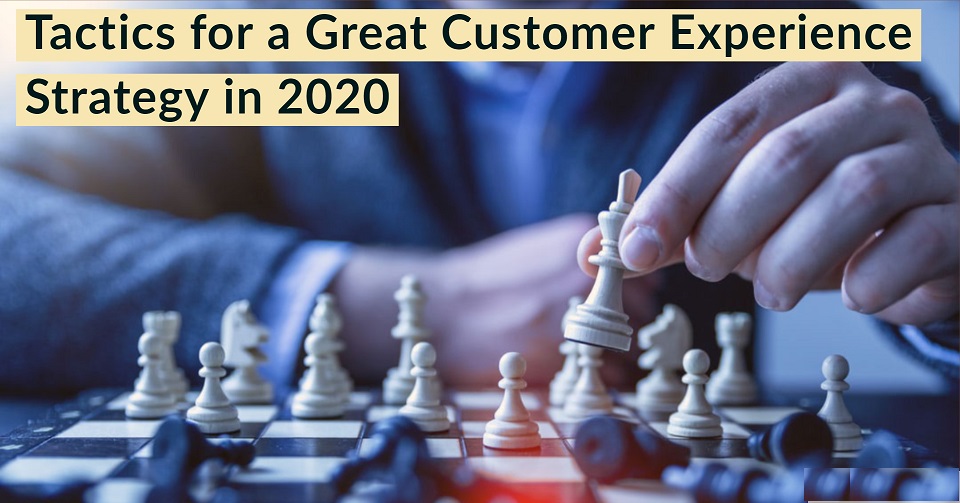Tactics for a Great Customer Experience Strategy in 2020


7mins
What is Customer Experience Management (CXM)?
Gartner defines customer experience management as “the practice of designing and reacting to customer interactions to meet or exceed their expectations, leading to greater customer satisfaction, loyalty, and advocacy.”
CXM is all about managing the end-to-end customer relationship across their entire journey with your brand — including all the different channels with which you choose to reach them.
Why Customer Experience Matters
1. Strong customer retention and customer loyalty.
An exceptional experience is a differentiator that creates brand loyalty and reduces customer churn — and it’s key to giving e-commerce retailers a competitive advantage.
The success rate of selling to existing customers is 60–70%, compared to a 5–20% success rate with new customers.
2. Higher LTV.
By offering the kind of experience that keeps customers coming back to your online store, you can avoid the potential revolving door of one-time customers and get more returns from your repeat visitors.
Loyal customers offer the opportunity for much higher lifetime value (LTV), sometimes referred to as Customer Lifetime Value (CLV).
3. Free promotion.
Word of mouth is one of the most effective ways to reach new customers. Today’s shoppers are warier than ever of retailers’ marketing messages or paid advertisements. But 81% report they do trust personal recommendations from friends and family.
Satisfied customers will talk about you and your products — to their friends and family, through the store and product reviews, and on social media.
To compete in the retail landscape in 2020, CX must be addressed as a series of touchpoints across the entire customer journey — not just discrete, disparate interactions. CX is an integral part of creating an overarching impression of your brand.
While there will always be factors outside of your control, here are things you can do to make sure your customers are receiving a high-quality experience they’ll tell their friends and family about.
1. Know your customers.
Understanding customer needs isn’t something you only do in the preparation stages of building your business. Retailers have to be prepared to respond to changing trends and adjust as the ideal customer profile evolves.
Customer engagement. If you aren’t providing them with opportunities to provide direct feedback, you may be missing out on valuable customer data.
Watching what they do — not just what they say. Pay attention to any metrics your various marketing tools can provide, like what ads they respond best to and where they off in the buyer’s journey.
You can get more feedback from your customers simply by asking them how you’re doing. Include feedback surveys on your site and invite comments and questions via post-purchase email communications to get more insight into the customer experience.
2. Make products easy to find.
For a great user experience on your online store, customers must be able to find what they’re looking for — quickly and easily — from your homepage as well as your category pages. That’s where product categorization and filtering come in.
Product categorization.
Product categories refer to groups of like products. To effectively categorize your products for your audience, you have to know how they think about and shop for the products you offer.
If you’re selling apparel, think about whether your customers search by type of clothing item or by occasion. Often, you’ll want to structure your online store so that shoppers can explore products, either way, depending on intent.
This can vary even within a certain niche. For example, some brands may be particularly known for their career-oriented clothing and choose to highlight that as a category, but for other brands that might not be a useful strategy.
Product filtering.
Once a customer chooses a category to explore, product filtering — also known as faceted search — provides a way to further refine product results by attributes like brand, price, color, and size to narrow the number of search results.
It’s easy to experience choice overload when faced with several pages of product results. Though it may seem counterintuitive, research shows that deciding among fewer choices is often better — both for sales and customer satisfaction.
3. Build great product pages.
The best product pages will strike a balance between providing all the information customers want about the product — without overwhelming them with information. A thorough description of the product, including details on dimensions, material, weight, and color, will help customers feel like they’re making an informed decision.
Product pages are also a great place to highlight benefits based on a use case to help customers determine if the product solves their particular problem.
4. Solicit customer feedback and highlight reviews.
As noted earlier, word of mouth is a boon for your business because of shoppers’ lack of trust in marketing and advertising. The same applies to the product level.
Product reviews can heavily influence buying decisions. A shopper may want to know, for example, that a product material is 90% polyester and 10% spandex. But it’s much more helpful to see reviews from real buyers with their honest opinions about the product and its performance “in the field.”
5. Educate your shoppers.
If you’re an expert in your field, adding helpful, informative content to your eCommerce site can be the difference between confusion and conversion. With a good content marketing strategy, your site can be a resource for customers researching a new product or an unfamiliar category.
6. Optimize for mobile.
We already made the case for the importance of mobile optimization, but to reiterate: if you want to capture your share of mobile shoppers, you must prioritize a positive user experience on devices like smartphones and tablets.
Responsive design, or web design that adjusts automatically to the size of the user’s screen, ensure that customers get a mobile experience similar in appearance and functionality to that on a desktop.
7. Make it personal.
Creating a personalized experience for your customers can increase their affinity for and loyalty to your brand. One element of personalization is addressing customers by name in your email communications. That’s a great place to start, but don’t stop there.
You can tap into the information you have about your customers to guide them toward content or products that are relevant to their unique interests. For example, if you know a customer frequently buys skincare products, you can provide them with relevant recommendations for new products they may like.
“Behavioral targeting is still the most impactful and least well-executed personalization tactic in eCommerce. Many companies do this at a basic level, implementing the core triggered emails like abandoned cart and browse abandonment emails. However, behavioral segmentation is limited only by your creativity and data utilization capabilities, and luckily, there are tons of tools out there that help with this nowadays.”
— Alex Birkett, Sr. Growth Marketing at HubSpot, co-founder of Omniscient Digital
Personalization works. One study found that 88% of customers feel more positively about a brand if they receive a more personalized experience.
8. Simplify your checkout process.
A streamlined checkout experience is not only exponentially less frustrating for your customers, but it also reduces the opportunities (and motivations) for them to abandon their cart.
Ideally, your checkout process should be contained within one page, including a variety of payment and shipping options. Avoid making customers fill out the same information twice, like entering billing and shipping addresses separately even if they’re the same.
More than half of customers say that filling out the same information more than once is the most frustrating part of the whole checkout process.
Offering customers the option to create an account on your site can add to their convenience. Knowing that their information will be saved (but only if they wish!) for ease of checkout on subsequent visits can encourage return visits. Particularly if they’re crunched for time or making a purchase on-the-go, customers may prefer to shop a store that already has their payment and shipping information.
Adding an item brings up a window that shows the entire cart, as well as shipping information, the opportunity to enter a promo code, and total cost. The button leading to the checkout page reduces the number of clicks it takes to complete the purchase.
9. Send clear emails.
The customer experience doesn’t end at “Confirm Purchase.” It’s just the beginning of another stage of the customer journey.
Despite today’s relative comfort with eCommerce, online purchases can still be stressful — especially big or particularly meaningful purchases. The payment information is entered, the final button is clicked, and … now what?
Keep your customers up to date on the status of their order with clear but friendly confirmation, package tracking, and other necessary post-purchase emails. Make sure any links are clearly labeled and any required action on their part is highlighted.
10. Ship faster.
When eCommerce first emerged, it was a big deal to be able to visit a website on the internet, click a few buttons, and receive items right to our doorsteps. Shipping and handling took time — that was the trade-off.
Today, customer expectations have soared. In a world where delivery has, in some cases, been reduced to just hours, customers are rarely willing to wait 7–10 days. In fact, in a recent survey, only 3% of consumers were willing to wait more than seven days for their purchase.
11. Provide timely, effective customer support.
In today’s always-on world, customers expect quick answers to their questions. Offering prompt and effective customer service and support is one of the best ways to boost customer experience.
According to this HubSpot Research survey, 90% of consumers want “immediate” responses from customer support, and 72% define “immediate” as “within 30 minutes.”
To improve your ability to provide excellent customer support, you need to be aware of every touchpoint you have with customers — from social media engagement to emails, to on-site chat and more.
With all of these touchpoints in mind, make sure your customer service team has the resources and processes they need to offer a holistic support experience.
Some of the top tactics for improving customer support include:
- Including your business contact information on every page of your online store,
- Considering integrating a chatbot to address customer questions in real-time, and
- Engaging with them on your social media channels.
Start 2020 on a strong Note, Start with VPCART




















 TrustGuard - PCI Security Scanner
TrustGuard - PCI Security Scanner
